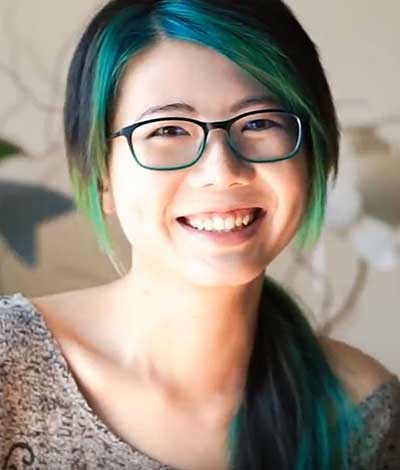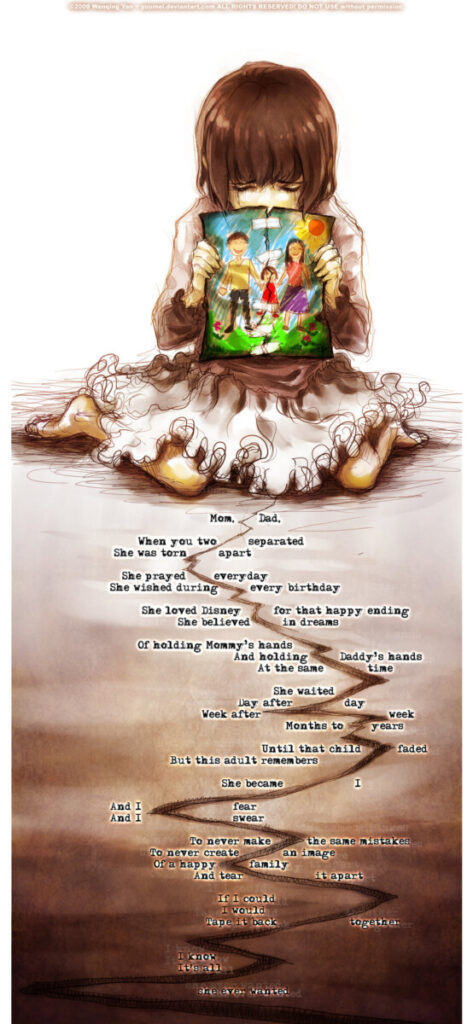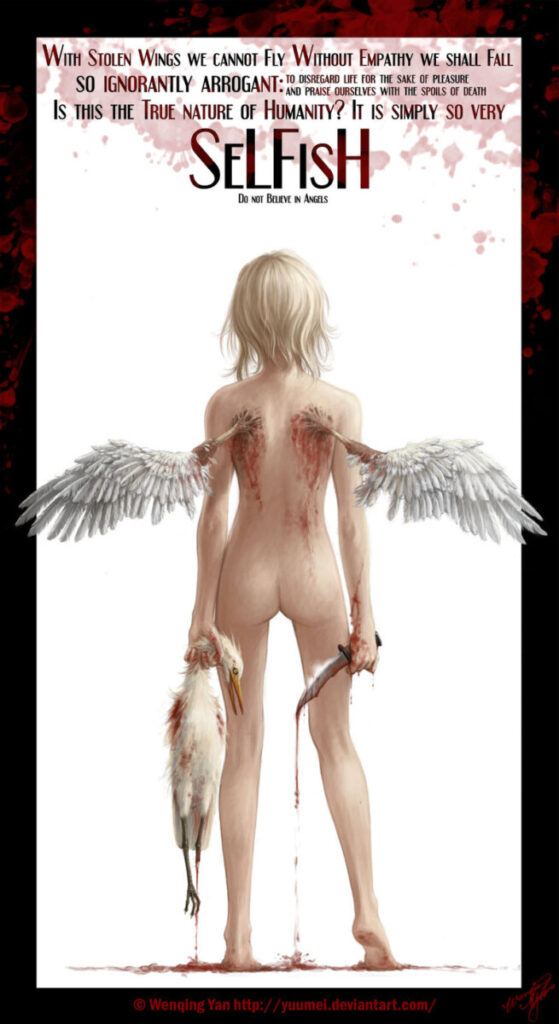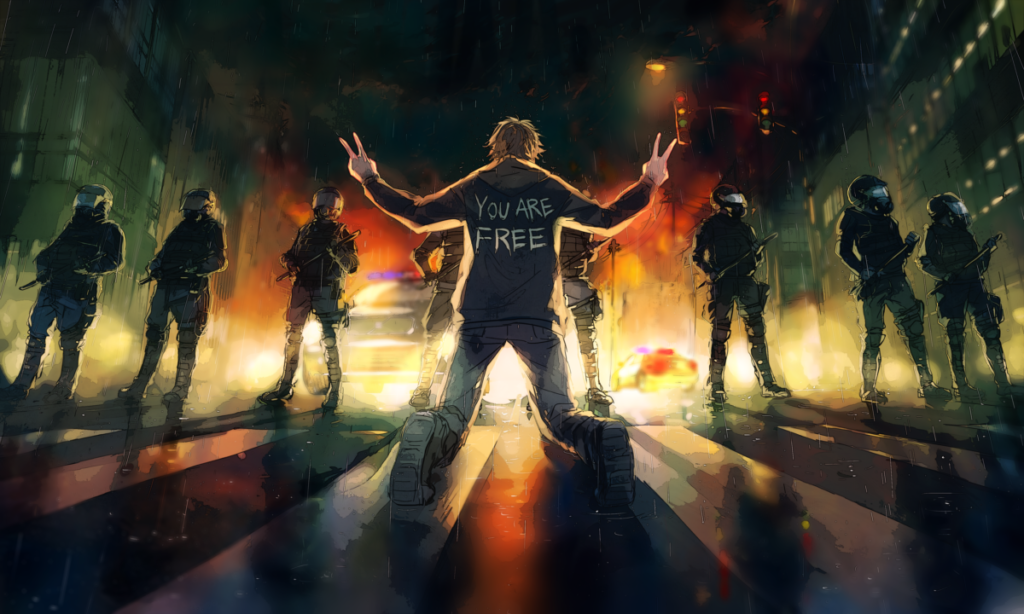A Look Into Digital Artist and Designer Yuumei and her Influence

The artist chosen for this assignment is Wenqing Yan, who is better known as Yuumei to her fans online. Yuumei is a Chinese-American digital artist and designer who became popular in the early 2000s via the online art community DeviantArt. It was some years later when I, an awkward teenager who spoke more words to online trolls than to my own family at the time, found myself making an account in that same online community where I discovered her work. The work that captivated me was an illustration titled “Tape It Back Together” which depicted a young girl (who is presumably Yuumei herself) holding up a torn up drawing of her family that she had desperately taped back together followed with cleverly placed text that both tells and shows of the rift between the little girl’s torn up family. The illustration had struck a nerve within me because while my own family was nowhere near the physical separation depicted in her illustration, there had always been a divide that separated us from one another despite our façade of a happy family. The more I learned about Yuumei, the more I began to realize that “oh, I relate to her because she’s like me. There’s others like me out there. I’m not the only one suffering.” Her works helped me recognize my depression, which in turn prompted me to desperately work towards a better outlook in life lest I wish to spend my life wallowing in self-pity.

The creative process is an interesting journey to explore because no matter which artist one might ask, the response for said process is always different from one artist to another. In the words of Yuumei, “Art is the language through which I interact with the world and with myself. It is a flurry of emotions, a stream of consciousness and subconsciousness. The creation process is also a journey of introspection. It helps me process and understand the events in my life, the society around me, and where I stand within it all.” For Yuumei, art is something that is closely linked with her emotions and outlook. In her retelling of her childhood, she explained that she created her first activist drawing titled “Selfish” when she had returned to China to visit her father. At the time, the government had issued an order for all dogs in the neighboring provinces to be slaughtered and had explained that it was done so as a precaution of rabies despite the fact that vaccinated dogs were not excluded from the tragedy that took place and despite the fact that the international free vaccines that were offered were refused. Yuumei’s activist drawing “Selfish” received countless responses from netizens who expressed that Yuumei’s art had “opened [their] eyes.”

Due to a split in her family, Yuumei grew up in the care of her grandparents and spent the first nine years of her life in China where she had attended Chinese art classes that focused on realism. She eventually obtained her visa and traveled to America to live with her then single mother. Yuumei was at the center of a custody battle between a father who had one too many lucrative get-rich-quick schemes in China and a depressed and suicidal single mother in America. At the age of 12, Yuumei joined the online art community DeviantArt and began to garner much recognition there. Much of her work is influenced by nature, personal experiences, and the “beauty and complexity of life” in her words. She is known for her webcomic “Fisheye Placebo” and her participation in founding the Axent Wear company. Despite having a very apparent gravitation to illustration, Yuumei also practices sculpting, photography, design, and storytelling when she is not illustrating.

Much if not all of Yuumei’s works are created with purpose. She has previously described herself as both an activist and a lover of animals and nature, which is apparent throughout her works. One of her first activist drawings, “Selfish,” was done so in response to China’s choice to indiscriminately slaughter all dogs in her neighboring provinces. The positive response to this piece is what propelled her to continue her expressions of activism via her art. In her webcomic “Fisheye Placebo,” she tells the story of how the main character is roped into a conspiracy to expose the corruption of an authoritarian regime in a world overrun by extensive censorship. Despite this webcomic being vastly successful at first, it was eventually linked to the 2019–2020 protests in Hong Kong. As a result, Yuumei was spammed with hateful and negative comments over her social media platform which even led to her being temporarily shadowbanned on Instagram. Not once did Yuumei stand down, however. In fact, the artist, spoke up against the wumaos (internet commentators who are hired by authority figures in China to essentially manipulate the public opinion) who tried to discredit her, solidifying her stance in support of Hong Kong and earning the much approval from her growing audience.

Yuumei’s art is inspirational and she has served as a role model for me from my early teenage years. As an introvert myself, I resonate with her thoughts on the creative process in that art is not just something to look at. It is a language, it is an expression of emotions, and it is something that can deliver a powerful message. Through her activist drawings, I had my eyes opened to the ugliness and cruelty of the world countless times. Through her art, I am encouraged to express my emotions in its truest forms. Rather than just inspiring me to be a better artist, I feel that Yuumei also inspires me to be a better person overall.
Works Cited
Yan, Wenqing. “About.” Yuumei Art, https://www.yuumeiart.com/about.
Yan, Wenqing. “Fisheye Placebo.” Yuumei, https://www.yuumeiart.com/fisheye-placebo.
Yan, Wenqing. “Selfish.” Yuumei, 13 Aug. 2006, https://www.yuumeiart.com/selfish.
Yan, Wenqing. “Tape it Back Together.” Yuumei, 6 Mar. 2009, https://www.yuumeiart.com/#/tape-it-back-together/.


